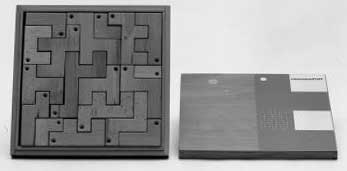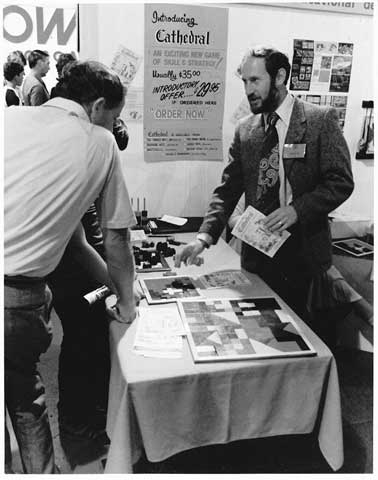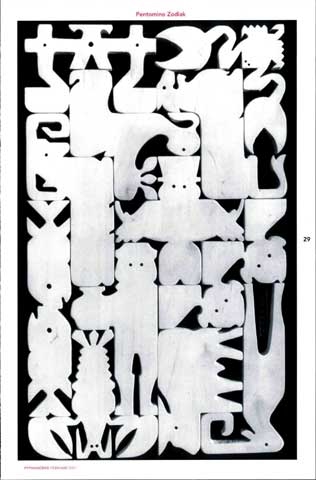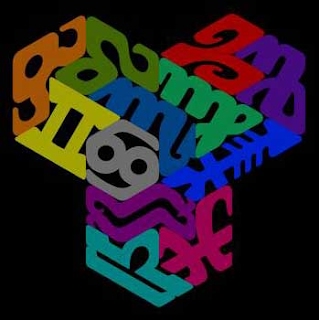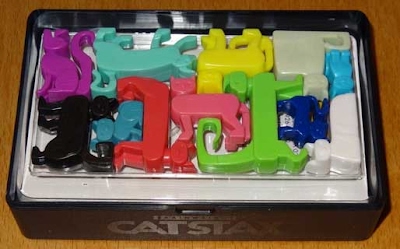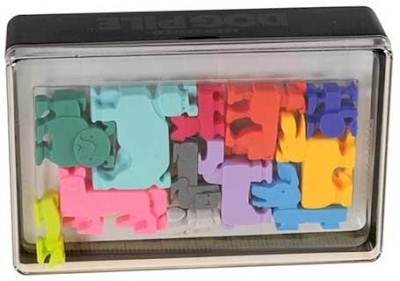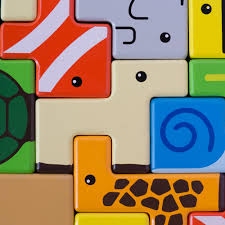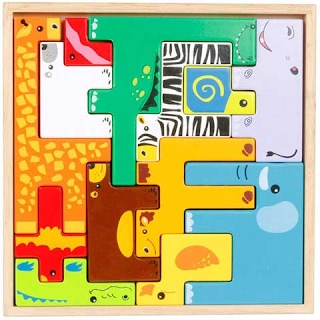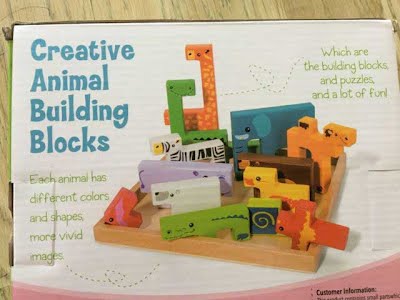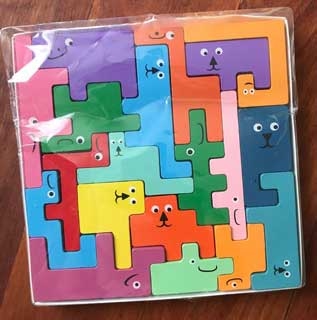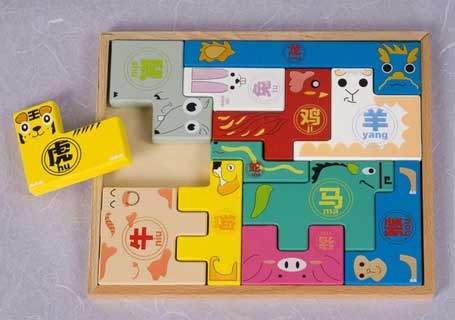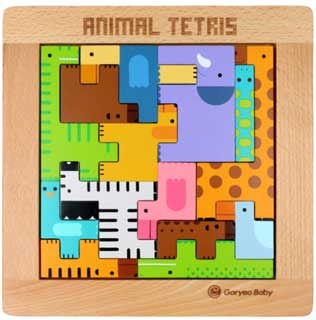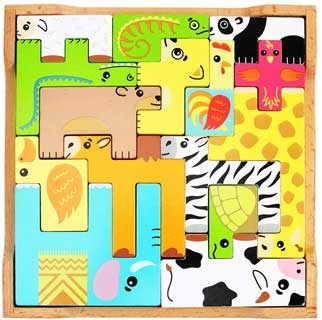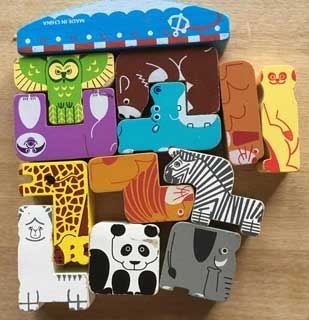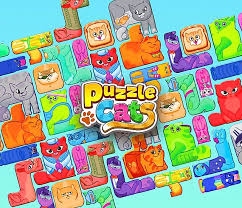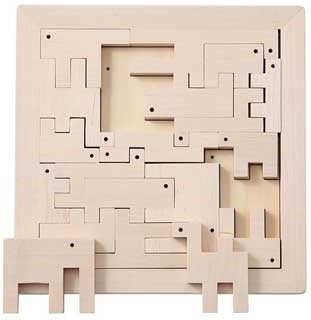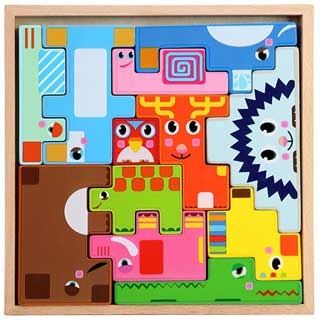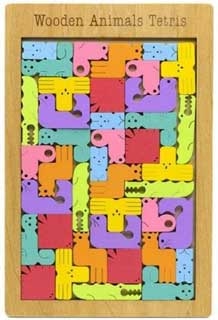Introduction Rather than essentially distinct themes without variations, such as Noah's Ark or Nativity scenes, I here show a variety of polyforms* (a plane figure constructed by joining together identical basic polygons), such as squares or equilateral triangles), namely with polyomino and polyiamond animal concepts (save for one exception, of buildings). Other titles the polyominoes go by are Katamino and Tetris (both games). However, although an apparently straightforward premise, with one-to-one correspondences, there are certain grey areas here, detailed below. This being so, on many occasions, concerning figures (and elsewhere), I prefix with ‘about’. About 18 distinct artists/designers with about 37 distinct works are identified (an exact count is impractical), albeit with qualifications. Further, the cluster puzzle purist (are there any others?!) may quibble at the inclusion of such a polyform category, as typically, especially so for the polyominoes when so formed into square or rectangular configurations, can tile the plane in a repeat manner. Therefore, the essential nature of non-repeating cluster puzzle is lost. However, as for any one puzzle, as a single element, is of a cluster puzzle nature, I have decided to include. Three different types of works can be discerned: (i) where the designer remains true to the polyomino/polyiamond, without any further refinements to the tile outline (e.g. Hans von Klier). (ii) where the designer introduces relatively minor edge articulations (e.g. Sabu Oguro). (iii) where the designer introduces relatively substantial edge articulations, but not way beyond the underlying polyomino recognition (e.g. Ton Schotten). All should be considered as acceptable, and not inferior to the other; a case can be made for any one type as superior/weaker to the others On this occasion, the investigation is largely decidedly hindered by a lack of detail on the people and puzzles themselves. Indeed, of the 17 artists/designers, I have only been able to detail in reasonable depth that by Hans von Klier, Sabu Oguro, Robert Moore, and Dan Klarskov. All the others remain decidedly obscure, to greater or lesser degrees, sometimes known only by a single puzzle reference without any background at all. This is perhaps all the more surprising in that about six of the instances here are by companies (as against individual people), some of more substantial than others, but still next to nothing is known of them. Part of the reason here is that there are no obvious means of contact (i.e. Muji or DASFG). Another is the passage of time; Klier for one and possibly Schotten are no longer with us, albeit even so, I still would have expected more than a trace of them would be known. Although the 17 artists are a reasonable amount, I would perhaps have expected more. Of the two types, polyominoes are by far the most favoured. Indeed, Oguro and Dahtamnay are the only designers to have undertaken polyiamond work. Although Dan Karskov has also undertaken such work, these may simply be copies of Oguro. Of the artists/designers here, the standout figure in the field is the work of Sabu Oguro. Indeed, in terms of sheer number he is head and shoulders above the rest. It is not even a close contest! Typically, any one person has just one or two puzzles to their name, whereas Oguro has so many that it is difficult to document. However, it is not a straightforward task to determine exactly how many. To this end, I give a minimum figure of 20, from the instances on his website. Possibly, the true figure runs into the hundreds. Dates are, regrettably, generally not given by the designer; only a few are known with certainty. Many instances below are prefixed with circa. This is generally, but not always, when I first saw this, for the sake of an approximation, no matter how crude. The designer's name is not always known, a not uncommon instance with companies. Only when the puzzle is marketed by individuals is this generally known. Also to be seen (but not included) are some board game puzzles where the polyomino aspect either serves as a backdrop or are little more than surface decoration, where the animal element is secondary to the polyomino. These include, some more overt than others: Arriaial, Second Chance, Realm of Sand, Indian Summer, Bärenpark, Silver&Gold, Patchwork, Isle of Cats puzzle game. In the same broad ‘faux’ vein, a series of puzzles were produced by Thinkfun, first of Tokyo Parking/Rush Hour (designed by the noted puzzler Nob Yoshigahara) and then others of the Rush Hour theme, with Traffic Jam, Railroad, and Safari. These consist of domino and tromino tiles. However, I have decided to exclude these from the main listing above, on the grounds of their minimal polyomino nature. I make no claim to this listing as being ‘all-inclusive’. By its very nature, the task is unresolvable. It is simply not possible to document ‘all’, given the worldwide distribution. However, by any standards, it is extremely thorough. I have now just about reached the point of diminishing returns. Although likely I could yet still find more, the time involved, say of many hours, would not be worth it to extend it more than by one instance each time. Any omissions can only be few in number, broadly stated. All in all, I have done my best, or at least of the time I want to devote to this. Additions and corrections are welcome. In particular, I would like to see instances of historical interest.
Inventory 1. Hans von Klier, 1958 (1) 2. Sabu Oguro, 1975 (20+) 3. Cathedral, by Bob Moore, 1978 (1) 4. Ton Schotten, c. 2001 (1) 5. Dahtamnay, c. 2011 (1) 6. Dan Klarskov, 2012? Date vague (5?) 7. Brainwright - Bob Farron/Mike Mendolese 2012, 2016, 2017 (3) 8. Dan Ngugen, 2013 (1) 9. DASFG’ et al?, 2013? (1) 10. Flying Tiger, c. 2016 (1) 11. ChinaSprout, c. 2020 (1) 12. Goryeo Baby, c. 2020 (1) 13. 'LBLA', c. 2020 (1) 14. Koshima's Shop/Rakuten, c 2020 (1) 15. MobilityWare, 2020 (1) 16. ‘Muji’ et al, c. 2020 (1) 17. 'RL', c. 2020 (1) 18. Wooden Animals Tetris, c. 2020 (1) The 18 Artists/Designers 1. Hans von Klier, 1958 Title: Tierbaukasten = Animal construction kit Date: 1958 Format: 10 x 10 Number of Puzzles: 1 Number of Tiles: 18 Type: 1 Material: Wood Size: Not Known Country of Origin: Germany Price (if known): The puzzle is seemingly unavailable. Possibly, it was never mass produced and/or marketed (c) Puzzle set in detail Hans von Klier (1934–2000), of Austrian, Czechoslovakia, was an international designer of some note of his day, although he is relatively little known today. Aside from his design work for Olivetti and others, during his student days at Ulm, he designed, in 1958, a single polyomino puzzle, titled Tierbaukasten = Animal construction kit. This instance is of some historical significance, as it is the first instance of any Escher-like animal (albeit heavily stylised) polyform puzzle. Therefore, given its significance, I thus discuss this entry in perhaps more detail than I do for the others here, or at least as much as is possible in the circumstances, as detail is relatively sparse. I am hindered in my investigations in that there is little detail available on this puzzle, it appearing largely in passing in a few design journals (amid his more popular design work) rather than the perhaps more obvious polyomino publications. However, in defence of the polyomino community, given the early date, when the literature was most sparse and can be said to have essentially begun in 1953 with the work of Solomon W. Golomb, and so such neglect is understandable. Indeed, so far as I am aware, the work here is, unfairly, still unknown in the polyform/polyomino community, as well as the Escher community. I have not seen a single reference to this in either field! (As an aside, I posted this on Twitter (September 2020, when I serendipitously first came across this), and it barely got a reaction from my 200+ followers (two likes, and no retweets! It undoubtedly deserved a better reception). The puzzle was first published in the in-house Ulm Journal of the Hochschule für Gestaltung, in 1962. The context was of a report of former students, as to how they had progressed. Amid the general discussion, this included a brief text about the puzzle, below, and a picture: Whilst still a student he designed an animal-shaped box of bricks. At the end of September his toys (‘bricks’?) will be exhibited in the gallery ‘Il Sestante’ in Milan. Interestingly, it can be seen side by side with Enzo Mari’s puzzle Animali. Whether Klier was inspired/aware of Mari’s slightly earlier work is unclear. However, given both their interest in design, it seems a distinct possibility. Klier’s single instance is of the purest type, type 1, without further refinements to the tile outline. The only suggestion of interior design for an animal motif is of a dot for an eye, but even so, without additional interior decoration, it is notable just how life-like many of the tiles can be. The puzzle is 10 x 10, of 18 polyominoes, of a variety and distribution. This includes: Domino - 1, Tromino - 2, Tetrominoes - none, Pentomino - 2, Hexomino - 6, Heptomino - 3, Octomino - 3, Enneomino - 1 It can be seen that some of the polyominoes repeat. As such, this does not appear to be based on any known puzzle and is likely an arbitrary division. The scale is not known.
References Anon. ‘Former Students’. Journal of the Hochschule für Gestaltung, October 1962. Hans von Klier, pp. 19-22. Bürdek, Bernhard E. Design: Geschichte, Theorie und Praxis der Produktgestaltung. Birkhäuser – Verlag für Architektur, 2005. See pp. 52-54, 123, 125, and 347. Note that only pp. 52-53 concern the puzzle; the other pages are in connection with his Italian collaboration Translated: Design: history, theory and practice of product design P. 53 shows a line drawing of the puzzle. 2. Sabu Oguro Title: Various. Dragon Cube, 8 Dogs, Bats and 7 Birds, Cat’s Cube, 7 Cubes, Zodiac and Dice, Zodiac (2), Bats and 7 Birds C, Ojama Mouse Cube, Zodiac S, Cat and Zodiac Cube, Bird Cube S, Zodiac Junior Polyform: Polyominoes and Polyiamonds Date: 1978+ Format: Various. 3 x 9, 6 x 6, 7 x 7, 6 x 10, 9 x 9, 3 x 10, 5 x 9 Number of Puzzles: 20+ Number of Tiles: Too many to list! Type: 2 Material: Wood Size: Too many to list! Country of Origin: Japan Cost (if known): (¥) 2,750 = £19.86; (¥) 19,800 = £142.98 Figure 2. (a) Pentomino Zodiac, (b) Polyominoes, Square, DogsSabu (or Saburo) Oguro (1936–), of Japan, is a Kumiki (to join wood together) designer of some note. Among his extensive commercial cluster puzzle work in general, he has about 20 polyomino cluster puzzles (and polyiamond, to a seemingly lesser degree), of a variety of animals. Perhaps of most note is that of the Chinese zodiac, namely a Rat, Ox, Tiger, Rabbit, Dragon, Snake, Horse, Goat, Monkey, Rooster, Dog, and Pig. The pieces are of unit thickness, and so can, and indeed are, extended to the third dimension as a polycube. The puzzle is of the ‘minimal’ incised type, where the motif is formed by artfully introduced carving. Although given the strict simple geometric outline of a polyomino, it is surprising how lifelike, although heavily stylised, the tile can be made to be. In the main, the motifs have artistic integrity. The puzzles, as a rule, are not dated. However, it is stated that the Zodiac puzzle is of 1978, whilst in the Dragon Cube entry, it is stated that Bird Cube was made in 1984. Given that the pentominoes have many rectangular configurations 2339(!), many subconfigurations can be made from this set. Perhaps by means of a back-handed compliment, copies can frequently be seen to be used by others, not all of which are credited (such as Will Witham and ‘his’ Noah's Ark). The puzzles are available from his shop U-Plan. The prices range from (low to high) (¥) 2,750 = £19.86 and (¥) 19,800 = £142.98 The puzzles are all of wood, with beech being favoured. Oak is also used, but to a much lesser extent, on occasion, a variety of woods are used in combination, such as beech, oak, paddock, and rosewood. These serve to better differentiate the individual pieces, and of which I find favour. However, there is nothing ‘wrong’ as such with the single wood puzzles. Although Oguro has apparently written widely on his puzzles, with no less than 13 books, his books are not readily available, seemingly purposefully so, only apparently available through his website. Further, it is not always clear from the previews what exactly the book is; not all appear to be strictly cluster puzzles. Even further, some are revisions and expansions of previous works. And then there's a partnership with another artist, *.Quite frankly, it is a veritable nightmare to unravel. Indeed, so much so that I have given up! Some books mooted (and are advertised) such as Making Marvelous Wooden Puzzles 70 Animal Families for Fox Chapel Publishing, 2014, apparently never materialised. (¥) 2,750 = £19.86; (¥) 19,800 = £142.98 * Beech, Oak, Paddock, Rosewood References Slocum, Jerry, and Jack Botermans. Puzzles Old & New: How to Make and Solve Them. University of Washington Press. First printed 1986. See p. 40. A picture and brief discussion in the context of pentomino puzzles. 3. Bob Moore Title: Cathedral Game Polyform: Polyominoes, 3D Date: 1978 (prototype), 1983 (manufactured) Format: 10 x 10 Number of Puzzles: 1 Number of Tiles: 29 Type: 1 Material: Various. Wood and Plastic Size: Not Known Country of Origin: New Zealand Cost (if known): £49.99 Figure 3. (a) Moore at Auckland show, Easter, 1981 - his raised hand can be seen above the puzzle. (b) Cathedral - the modern 3D versionRobert (Bob) Moore (16 August 1942–19 June 1998), of New Zealand, once a pilot in the Royal New Zealand Air Force (and of which his airforce days indirectly eventually led to the puzzle), has a single themed commercial (3D) polyomino puzzle game with Cathedral. This has met with much success, with worldwide distribution and acclaim. The idea of the game is to capture territory on the game board, allowing you to place all of your polyomino game pieces while preventing your opponent from doing likewise. Strictly, as this thus differs from a ‘normal’ polyomino puzzle of fitting the pieces into (typically) a square or rectangular array, without gaps, as the prototype is indeed of a ‘normal’ puzzle, I have decided to include it nonetheless. For once here, with an official website by the rights holder, Chrisbo I.P. Holdings Limited, the story of Moore and the puzzle itself can be told, with a detailed history on Moore as well as the genesis of the puzzle on the site. Further, the game is discussed by other sources elsewhere to complete the story. Below I excerpt details. This is described on the Chrisbo history page as In 1962 Robert (Bob) Moore was a young pilot in the Royal New Zealand Airforce at Wigram Airbase in Christchurch. During training in Harvard Aircraft, Robert found the Christchurch Cathedral an easy landmark to use as a waypoint during turning maneuvers and would look down the wing and take a fix on the Cathedral spire. Flying was his passion and he used to marvel at the tiny buildings and roads which appeared toy-like below. One thing that fascinated him was the way the buildings interlocked so perfectly, like a jigsaw. The memory later, during his occupation in planning and production at a can factory, germinated as an idea for a new game of various shaped building like pieces, to be fitted on a board by two opposing players. After years of study and design the first prototype of Cathedral was born. The idea was quickly patented. About 1979 Bob took his invention to a wooden game and toy manufacturer called Brightway Products who saw the potential and began first production of a flat abstract and a 3d version of the game. The 3d version with it's buildings and turrets proved most popular. The North American market was established by John Davidson who during a business trip to New Zealand saw the game and bought one as a gift. He was fascinated by it and saw the potential for the development of the game on the North American market. To satisfy this market in the U.S. Bob set up his own production, subcontracting much overflow to Brightway. The writer/webmaster also spent a year making the game with his brother. The game saw a steady growth until the present day where it has been made in four locations around the world and is found in North America, United Kingdom, Europe, Australia, parts of Asia and of course New Zealand. Of particular interest here as to the success of the game is the abandonment of a 2D version in favour of a 3D version. This is understandable, in that a 3D version is more obvious, as against flat, largely abstract geometric shapes. Timeline. From Museum page and exterior sources, text rearranged, edited: 1978 The very first prototype model. After some experimentation the very first practical game was made from balsa wood. A limited number were made from plaster of Paris, based on this design. All the basic shapes as they appear now were developed on this model. A very early production model was made in two dimensional abstract form. The formal design proved so popular that the 2d version was soon discontinued. 1981 The first public trade showing of Cathedral at the 1981 Easter Show in Auckland New Zealand. 1983 Cathedral won the then prestigious Design Mark Award, for excellence in design and manufacture. 1985 The game was published by Mattel using plastic pieces. There are 29 polyomino pieces, all small abstracts of buildings, set in a 10 x 10 square grid. One building is the Cathedral, painted grey. The rest of the buildings are divided into 14 dark and 14 light pieces, one set for each player. The polyominoes are arbitrary, with: monomino (4), domino (4) L-tromino (4) Square (2 x 2) (2). Of an initial look, I could not find the patent. References https://www.cathedral-game.co.nz/history.htm https://www.cathedral-game.co.nz/museum.htm https://en.wikipedia.org/wiki/Cathedral_(board_game) 4. Ton Schotten Title: Pentomino Zodiak Polyform: Polyominoes Date: c. 1981 (the first reference) Format: 6 x 10 Number of Puzzles: 1 Number of Tiles: 12 Type: 1 Material: Wood Size: Not Known Country of Origin: Netherlands Cost (if known): - Figure 4. Pentomino ZodiakTon Schotten (1931–) of Heerhugowaard, the Netherlands, apparently a sculptor and painter, has a single known pentomino cluster puzzle, titled Pentomino Zodiak. However, this is about all that is known about him and the puzzle! He is near anonymous on the web. He possibly once had a website, but if so it is no longer operable. He is unknown on social media (Twitter and Facebook). The puzzle appears to have been awarded as competition prizes on a pentomino website. His work appeared in the Dutch mathematics journal Pythagoras in an article on pentominoes, albeit with minimal biographical information, which at least led to the above. A translation is shown below: The figure on the right shows a work of art made by Ton Schooten from Heerhugowaard. They are shapes cut out of figures. With a little goodwill, human and animal figures can be recognized in the worms; a lobster, a scorpion, fish twins, a bull. What do these shapes remind you of? Right, the zodiac signs from the horoscope. Just see if you recognize the other figures as a constellation. Ton Schotten called this artwork "Pentomino zodiac". Zodiac is a tough one for the zodiac. Pentomino zodiac What does jigsaw have to do with math? The title gives us another hint: pentominoes. Treated before; these are exactly all shapes that you can put together from five equal squares. There are also exactly twelve different pentominoes, see figure 1. There are also exactly twelve constellations. This gave Ton Schotten the idea of designing the twelve pentominoes as constellations. The result is a decorative jigsaw puzzle consisting of twelve pieces. The twelve constellations fit exactly into a 6 by 10 rectangle, as you can see in the picture. However, this is just one of the many ways you can arrange the pentomino pieces in a 6 by 10 rectangle. Can you find another way? I find the puzzle most impressive and it says much for the designer's imagination. Most of the figures are readily discernible as of the zodiac: Gemini (Twins); Cancer (Crab); Leo (Lion); Virgo (Virgin); Libra (Balance); Scorpius (Scorpion); Sagittarius (Archer); Capricornus (Goat); Aquarius (Water Bearer); and Pisces (Fish). Similar in style is the work of Bob Farron of Brainwright; see above, although his has a 3D element. The puzzle is of wood, and is near minimal, without interior detail, save for the eyes of each motif. The presentation is (pleasingly) consistent throughout. The puzzle is not dated as such. As the earliest reference is 2001, this at least gives an indication, but nothing more. As ever here, does anyone know of Schotten or further details of the above? As of this writing (2020) would be 89, and so perhaps he is no longer with us? No detail is too small to know. References Zaal, Chris. ‘Beeld puzzel’ (Picture puzzle). Pythagoras, February 2001, pp. 28-29 Pythagoras, November 2003, p. 29. Minor reference 5. Dahtamnay Title: Zodiak Polyform: Polyiamonds Date: c. 2011 (first reference) Format: 6 x 10 Number of Puzzles: 1 Number of Tiles: 12 Type: 1 Material: Artwork Size: Not Known Country of Origin: Netherlands Cost (if known): On application to Dahtamnay Fig. 5. Zodiac. HexiamondDahtamnay (1987-) (real name unknown), an artist, has on DeviantArt a single themed hexiamond puzzle, as an artwork, titled Zodiac. It is described as ... this hexiamond set styled after the symbols of the zodiac. The hexiamonds are the shapes that can be made by joining six equilateral triangles together. There are exactly twelve ways to do so, hence the association with the zodiac. My initial sketches for this set are actually fairly old, and my inspiration came from a similar design for the pentominoes by Ton Schotten. Schotten's work actually depicts the animal and human figures of the zodiac, so I decided to base my hexiamonds on their related symbols instead. The hexiamonds form a nice puzzle, as they can be arranged in a wide variety of interesting shapes. Interestingly he credits Ton Schotten (see above) as the inspiration. However, this indeed is original, and markedly differs from Schotten’s work. The artwork is not dated as such, but it appears to be around 2011, when it was published on DeviantArt. Certainly, given that Schotten’s work is of 2001, it cannot be any earlier than that date. The puzzle is of the incised type, type 3, where the motif is formed by artfully introduced articulations, but still retaining the underlying hexiamond. Although given the strict simple geometric outline of a hexiamond, it is surprising how representational, although heavily stylised, the tile can be made to be. In the main, the motifs have artistic integrity; the symbols of the zodiac are obvious. 6. Dan Klarskov Titles: PentaZoo step game, PentaZoo Square, CornucopiaZoo Step game, and TenYen Minizoo Polyform: Polyominoes and Polyiamonds Date: 2012? Format: 6 x 12, 6 x 6, 6 x 17, 8 x 8 Number of Puzzles: 5 Number of Tiles: Various Type: 2 Material: Wood Size: Not known Country of Origin: Denmark Cost (if known): On application to Klarskov Fig. 6. Hexiamond Zoo HeartDan Klarskov, a puzzle designer and musician, of Odense, Denmark, has a series of wooden pentomino and hexiamond puzzles in the style of Sabu Oguro, of whom he freely credits as the inspiration of his works. He website shows instances described as: (1) Pentominoes PentaZoo step game (6 x 12), PentaZoo Square (8 x 8), CornucopiaZoo Step game (6 x 17), and ‘TenYen Minizoo’ (6 x 6) (2) Hexiamonds Hexiamond Zoo step game, Hexiamond Zoo Heart However, despite correspondence, it is not entirely clear as to the degree of originality here. Some motifs can be seen to be from Oguro’s work, whilst others I am not sure. Aside from what is an orthodox puzzle, there are also instances of what he terms as ‘step game’, which can be described as Katamino, as devised by the Frenchman André Perriolat, in 1992. The puzzles are in a variety of woods, thereby making the recognition of the animals easier (as against a single wood), of which type I prefer. http://www.klarskov.net/puzzlefront.htm 7. Brainwright - Bob Farron and Mike Mendolese Titles: Cat Stax, Dog Pile, and Haystax Polyform: 3D Polyominoes Dates: 2012, 2016, 2017 Format: 6 x 10, 6 x 12 (2) Number of Puzzles: 3 Number of Tiles: 12, 12, and 9 Type: 2 Material: Plastic Size: Not Known Country of Origin: US Cost (if known): £14.99 Brainwright, a division of Ceaco, Inc*., of the US, is a broad geometrical puzzle company. Among Brainwright’s 30-puzzle range are three themed polyomino 3D cluster puzzles, with the date and number of animals in brackets, namely Cat Stax (2012, 6 x 12, 12 pieces), Dog Pile (2016, 6 x 12, 12 pieces), and Haystax (2017, 6 x 8, 9 pieces) (the last of barn animals). Unlike other such polyomino puzzles in this listing, the underlying polyominoes are not as overt as others, but nonetheless it is there, but easily missed of a casual glance. The pieces are of unit thickness, and so can also be assembled into cube and rectangle puzzles, and of which this possibility is made explicit. They describe themselves, albeit somewhat briefly, as ...our collection of brainteasers, mind-benders, and logic puzzles for "curious minds”. All of our products are made to the highest quality standards, while offering to stimulate your mind, improve memory, and hone fine motor skills. There's something for all ages and abilities at Brainwright. Have a look around... We think you'll love the challenge! However much of the background of Brainwright is unknown; their website is not particularly forthcoming on the people involved here. Quite who is the overall head and the size of the company is unclear. However, likely it is relatively small; Ceaco Inc. employs just eight people. Possibly, it is just a one-person concern. Although the people involved are not stated on their website, it is stated elsewhere: Cat Stax was invented by Bob Farron and designed by Mike Mendolese from Brainwright. And even this is open to interpretation! Are both people from Brainwright, or just Mike Mendolese? Further investigation led to Bob Farron’s site ‘Tangerine Creative’, where he is described as a ‘toy and game designer’ he is plainly credited as the designer as such of each puzzle i.e. his artwork. Mike Mendolese's role is less certain. Possibly he is the Brainwright ‘promoter’ in the broader sense? The puzzle is of the incised type, in the style of Sabu Ogouro, where the motif is formed by artfully introduced carving. However, there are differences between the two; Oguro’s is ‘minimal’ whilst Brainwright is much more extensive in the, in effect, ‘carving’. Indeed, there is a pronounced 3D nature to these. Similar in style, but without the 3D element, is the work of Ton Schotten; see above. However, the puzzle still retains the polyomino premise. No one style should be considered as inferior/superior, but instead as different; both styles should be considered as acceptable. Although given the strict simple geometric outline of a polyomino, it is surprising how lifelike, although stylised on occasion, the tile can be made to be. In the main, the motifs have artistic integrity. The polyominoes are in a variety of units. Each is described as follows: Cat Stax The Purrfect Puzzle Stack up the cats! Select a challenge and then arrange all of the cats on the card so that they fit perfectly within the grid. The cats come in all shapes and sizes, so you'll have to figure out how they precisely nestle together to solve each challenge. Paw your way through all 48 puzzles and consider yourself one clever cat! Dog Pile The Pup-Packing Puzzle Pile up the pups! Select a challenge and then arrange all of the dogs on the card so that they fit precisely on the grid. The dogs come in all shapes and sizes, so you'll have to figure out how they nestle together to solve each challenge. Paw your way through all 48 puzzles and you’re the top dog! Haystax The Barnyard Packing Puzzle Herd the horse, pack the pig, and stack the sheep! Select a challenge and arrange the farm animals so they all fit precisely in their pen. The animals come in various shapes and sizes, so you'll have to use your best spatial skills to correctly corral them together. With 36 increasingly difficult puzzles, you'll be stacking 'til the cows come home! Quite witty! Each puzzle is supplied with a card giving various configurations to attempt, as a game. Interestingly, they can be seen not to have all been released at the same time. This suggests that upon an initial success with Cat Stax, this then led to a follow-up, with Dog Pile, and again, with Haystax. The puzzle comes in a travel box with a transparent lid (easier to keep track of your cats that way). The puzzles are extensively promoted online from a variety of sources and are available from the Brainwright website and a variety of online merchandisers. Each retails for £14.99. Overall, I find favour with these. 8. Dan Nguyen Title: Animal Stackers Polyform: Polyominoes Date: 2013 Format: Unclear Number of Puzzles: 1 Number of Tiles: 9 Type: 1 Material: Wood Size: 4½” x 10½” x 2¼” Country of Origin: US Cost (if known): $35 Figure 8. Detail of Animal StackersDan Nguyen, of Fremont, California, USA, and a graduate of Stanford University, has a single polyomino cluster puzzle, titled Animal Stackers. This is described on his website (1) and Kickstarter page (2) as: (1) Animal Stackers are made from all-natural beech wood and painted with non-toxic, water based paints. Each set comes with nine unique wooden pieces, with many more to come! (2) Animal Stackers is a new kind of building block for boys and girls. Usually, boys like building things and tearing them down while girls enjoy telling a story and role-playing. Animal Stackers is a simple and elegant solution that reaches across genders and ages. The puzzle was of a recent (2013) Kickstarter venture, with pledges of $70,620 of a $42,000 goal, with 1,069 backers, which is quite impressive! The puzzle is not dated as such, but given the Kickstarter date, it seems reasonable to assume a contemporary date. The style is of a children's nature and is stated as such. Like most others here, the puzzle has a dual purpose, as a polyomino puzzle as well as a plaything as a stacking toy in its own right, as the title suggests. Indeed, it is promoted much more so in the latter way. The puzzle is of 9-pieces (with the number of polyominoes in brackets), of a clownish (6), snail (5), snake (6), dog (7), elephant (8), turtle (10), bison (10), giraffe (7), and one unidentifiable, described as a ‘mystery’ (6). Some of the animals are more stylised than others but are still largely recognisable. Curiously, the puzzle is not shown in its complete state, as a planar solution, but rather as a partial tiling and, more typically as a series of individual pieces as a stacking toy. Likely this must be purposeful, to retain the puzzle element. Quite what the polyomino array is, if indeed any, is unclear. It is not entirely clear if this is indeed of a square or rectangle; it may simply be an arbitrary outline patch (the only tiling picture is cropped). Given that I calculate 65 squares, it cannot be a square, but perhaps I have miscounted! I lack the will and time to investigate when the task could have been made easier by simply showing the puzzle in its planar state in the promotional detail. The puzzle measures 4½” x 10½” x 2¼” and retails for $35.00, available from his website. https://www.animal-stackers.com/ https://www.kickstarter.com/projects/dannguyen/animal-stackers-a-new-kind-of-building-block (includes video) 9. ‘DASGF’ Title: Wooden Animal Creative Building Blocks Puzzle Polyform: Polyominoes Date: 2017 (first saw) Format: 12 x 12 Number of Puzzles: 1 Number of Tiles: 13 Type: 1 Material: Wood Size: 8½” x 8½” x ¾” Country of Origin: Not known Cost (if known): £55 Figure 9. (a) DASGF puzzle; (b) Box A puzzle seemingly by ‘DASGF’, of which beyond the possible manufacturer the background remains unknown, despite it being marketed extensively in various countries worldwide, on the web, and in particular on Amazon. However, the background situation is most unclear and nothing here is certain. Another name it is marketed under is ‘Buyger’, and others! Pending more detail coming to light I will describe it as DASGF for the sale of convenience. It is described by DASGF as: DASGF Wooden Animal Creative Building Blocks Puzzle YID Children's Building Brand However, DASGF may merely be a store of some kind, as the puzzle is variously described. From the promotional material, a possibility is that it is Russian. The 13-piece, 8½” x 8½” x ¾”, 12 x 12 animal puzzle is curious in that unlike others here, it is of ‘many’ polyominoes, ranging from 3 to 23, rather than, say, entirely of pentominoes. Possibly the designer has taken an existing curvilinear puzzle and either directly or indirectly, pixelated it, and then duly used this as the basic design. The animals include, with the number of polyominoes in brackets, Giraffe (17), Polar Bear (9), Bird (6), Crocodile (7), Fish (3), Dinosaur (18), Zebra (10), Bear (11), Camel (13), Duck (8), Snail (5) Rhino (14), and Elephant (23). It is notable just how life-like many of the tiles can be seen to be. For instance, a dinosaur, giraffe, camel and elephant, in particular, can easily be seen, whilst the others pass off as a variety of generic quadruped creatures of plausibility. The one weak instance is of the bird, which is unrecognisable. The puzzle has artistic integrity. The style is of a children's nature, with a broad premise of realistic colouring. It is available in painted pine wood, with the animals in bright colours with simple interior detail. As with many others, there appears to be a dual purpose, with the pieces as playthings in their own right, as they can be made to stand up individually. The puzzle, save for the interior detail, is in the same style as the earliest known instance, 1958, by the Austrian designer Hans von Klier, above. Whether his work influenced this is unclear, but likely not, as that puzzle is decidedly obscure, but it's not impossible. Does anyone know more background details on this? 10. Flying Tiger Title: Puselspil = puzzle Polyform: Polyominoes Date: 2016 (the first reference, but could be much earlier, but no earlier than 1995) Format: 16 x 16 Number of Puzzles: 1 Number of Tiles: 19 Type: 1 Material: Wood Size: 9” x 12” (23 x 30.5 cm). However, this does not tally with the square format! Country of Origin: Denmark Cost (if known): - Fig. 10. Flying Tiger puzzle A puzzle from Flying Tiger, a Copenhagen, Danish variety store chain, with branches around the world, in 29 countries with 900+ stores in 2 continents (Europe and Asia), of which 71 are in Denmark. It seems primarily a brick and mortar enterprise; only in 2020 did it go online. The chain sells a variety of items, mostly accessories and toys, with the occasional puzzle, although this is the only polyomino instance. However, much background detail of the puzzle itself remains unresolved; it is not to be found on their (largely minimalist) website. It is simply described on the packaging as a generic ‘puselspil’ = puzzle, ‘Designed by Tiger’ (before June 2016, the company operated as Tiger in most places) and, translated, ‘with changing motif’. Oddly, of the 18 countries listed on the reverse, it is not in English! The specific designer’s name and date remain unknown. The earliest reference I have seen to it is of 2016, and as the first store opened in 1995, this at least gives the earliest date. It is at least relatively modern. Owing to the worldwide distribution, it can be seen in a variety of locations, and so is arguably one of the more popular instances of its type. The puzzle is of a 16 x 16 array, in coloured wood, of 19 animal pieces, with the polyominoes ranging from 9 to 22 units. The formation appears to be random. Specifically with numbers of polyominoes and frequency in brackets:9 (1); 10 (1); 11 (3), 12 (3); 13 (3); 14 (2); 15 (3); 17 (1); 18 (1); and 22 (1) The puzzle is of a child nature, of simple, cartoon-style animals brightly coloured, of one tile, one colour. Each animal has eyes and a nose but is without any other interior detail. It varies in its artistic integrity as it is heavily stylised at times. Recognisable, although stylised, are a giraffe, dog, and snake. A variety of quadruped animals that are strictly vague as to interpretation can be discerned, along with many others clearly lacking in identity, best described as ‘generic’ animals. The puzzle is at least consistent in style. It is unclear as to the thickness of the polyominoes, and so whether there is dual purpose play element or 3D possibility to this is unclear. However, from the picture, there is no obvious depth to the puzzle, and so I consider additional usage unlikely. Does anyone know more background details on this? 11. ChinaSprout, Chinese Zodiac Jigsaw Puzzle, C. 2020 Title: Chinese Zodiac Jigsaw Puzzle Polyform: Polyominoes Date: 2020 (the first reference, could be earlier) Format: Number of Puzzles: 1 Number of Tiles: 12 Type: 1 Material: Wood Size: 8¾" x 10¼" Country of Origin: US Cost (if known): $24.95 Fig. 11. ChinaSprout Puzzle ChinaSprout, a children's educational online store, based in the US but with China origins, has a single themed broad polyomino-type cluster puzzle (although described as a tangram puzzle, which it is not!) with Chinese Zodiac Jigsaw Puzzle. It is described as: This tangram puzzle features 12 different shaped wooden pieces, each representing a Chinese zodiac animal. It is perfect for children to learn about Chinese zodiac while having fun fitting all the pieces in the box. Each piece shows a simplified Chinese character representing an animal with Pinyin and a picture. Create countless designs with this Chinese zodiac puzzle, all while learning about an important aspect of Chinese culture! Wood, 8.75"x10.25"x2”, 12 Pieces Interestingly, it is not described as a polyomino puzzle but rather as a tangram! Perhaps this was a marketing policy, with ‘polyomino’ being an unusual term, whereas tangram is not. Or perhaps just an error? As alluded to above, I describe this as a ‘broad’ polyomino-type puzzle. Quite best how to place this is unclear. Strictly, it is not a conventional polyomino puzzle, with the same unit squares. The squares here ‘differ’. However, it is not of the nature of a looser connection, as with the ‘not quites’. So what to do? There seems to be no one ideal placement. Therefore, for now at least, as it appears to be ‘orthodox’ (although strictly not), I have placed it in the main body of instances, albeit with due reservation. As well as a fun puzzle, it is clearly stated as an educational purpose, learning about the Chinese Zodiac*. Given that to western audiences the 12 animals are not well known, these include: Rat, Ox, Tiger, Rabbit, Dragon, Snake, Horse, Goat, Monkey, Rooster, Dog, and Pig. The animals are heavily stylised, and without the interior detail and colour, would otherwise largely be unrecognisable. The puzzle is not dated as such but is obviously modern, loosely defined. ChinaSprout began in 1999, and so this thus places the earliest possible date. I first saw this in 2020. For now at least, I will place under 2020. The designer, as with most company-based marketeers, is not stated. In short, it’s obviously a fun puzzle, for children, without pretence as to ‘high art’. Within its category, there's nothing wrong with that, but as is, when compared to others here (rightly or wrongly), it significantly pales. It is available from ChinaSprout: http://www.chinasprout.com/shop/ATG237 * The Chinese zodiac and its variations remain popular in many East Asian and Southeast Asian countries, such as Japan, South Korea, Vietnam, Cambodia, and Thailand. Many puzzles, in general, are based on the Zodiac. 12. Animal Tetris Title: Animal Tetris Polyform: Polyominoes Date: 2020 (first reference; could be earlier) Format: 12 x 12 Number of Puzzles: 1 Number of Tiles: 14 Type: 1 Material: Wood (Beech) Size: 9½” x 9½” x ½” Country of Origin: Unclear. Possibly Vietnam, Korea or China Cost (if known): £23 Fig. 12. Animal Tetris - Goryeo BabyA puzzle, titled Animal Tetris, by ‘Goryeo Baby’, or at least branded as such, of Vietnam, a shop specializes in providing wholesale and retail genuine baby safe toys. However, the puzzle also has Korean and China associations, and so who properly to designate this to is unclear. It is marketed extensively in various countries worldwide, on the web, and in particular on Amazon. There doesn't appear to be any documentation. Pending more detail coming to light I will describe it as by ‘Goryeo Baby’ for the sale of convenience. It is described/titled as: Cute Animal Cartoon Shape Tetris Building Blocks Kids Educational Jigsaw Puzzle Made of high-quality wood, hard material, playability, drop-proof and not easily deformed. The style (as stated) is plainly of a children’s puzzle, with cartoon-style graphics. Each animal is of multi bright colours, with interior detail, with the colouring largely being true to the animal supposedly being portrayed. The polyominoes range from 5 units (Snake) to 20 (Elephant). The designer's name is not given, a not uncommon occurrence with such ‘company’ puzzles. The puzzle is not dated, but appears to be modern, loosely stated. I first saw this in 2020. It is clearly shown as a dual purpose toy, with the possibility of stacking. The formation of the polyominoes appears to be random. The animals, although stylised at times, are largely recognisable, aided by the coloring and coat marking. Specifically recognisable, with numbers of polyominoes in brackets: Bear? (9), Bird? (6), Crocodile (9), Dog (10), Duck (8), Eagle (12), Elephant (20), Giraffe (14, 17), Leopard? (6), Snail (5), Snake (5), Tiger (6), Zebra (15). As such, it is perhaps one of the better children's puzzles; most of the animals are recognisable. 13. LBLA Title: Wooden Puzzle Animals Tetris Puzzle Polyform: Polyominoes Date: 2020 (the first reference; could be earlier) Format: 12 x12 Number of Puzzles: 1 Number of Tiles: 15 Type: 1 Material: Wood Size: 8½” x 8½” Country of Origin: Not Known Cost (if known): Figure 13. LBLAA puzzle seemingly by ‘LBLA’, of which beyond the possible manufacturer the background remains unknown, despite it being marketed extensively in various countries worldwide, on the web, and in particular on Amazon. Pending more detail coming to light I will describe it as LBLA for the sale of convenience. It is described by LBLA as: LBLA Wooden Puzzle Animals Tetris Puzzle. The style is plainly of a children’s puzzle. There doesn't appear to be any documentation. Each animal is portrayed in a cartoon-like manner, of bright realistic colours e.g. black and white for the cow, and appropriate interior detail. The puzzle is of a 12 x 12 array, 8½” X 8½”, in wood, of 15 animal pieces, with the polyominoes ranging from 5 (Bird and Snail) to 23 (elephant) units. The designer's name is not given, a not uncommon occurrence with such ‘company’ puzzles. The puzzle is not dated, but papers to be modern, loosely stated. I first saw this in 2020. It is clearly shown as a dual purpose toy, with the possibility of stacking. The formation of the polyominoes appears to be random. Specifically with numbers of polyominoes and frequency in brackets: Bird (5), Bear (11), Camel (13), Chameleon? (6), Cow (14), Crocodile (9), Duck (8), Elephant (23), Giraffe (14), Hen (6), Lamb (6), Panda (6), Snail? (5), Unidentified Quadruped (8), and Zebra (10) There is an undoubted connection here to the DASFG puzzle; about half of the animals in a block are to be seen in both puzzles, albeit with on occasion a change of animal detail. For instance, the rhino of the DASFG becomes a cow here. There is too much of the sameness here for it to be a case of reinvention. A possible explanation is that it is by the same designer, as a variation. Or one puzzle could be a part copy of the other. It is simply impossible to tell. 14. Koshima's Shop/Rakuten Title: Animal Puzzle (Children's Challenge) Polyform: Polyominoes Date: 2020 (the first reference, but could be much earlier) Format: Unclear Number of Puzzles: 1 Number of Tiles: 10 Type: 2 Material: Wood Size: Unknown Country of Origin: Japan Cost (if known): - Figure 14. Koshima's ShopA puzzle from ‘Koshima's Shop’, on Rakuten, the largest e-commerce site in Japan. However, much background detail of the puzzle itself remains unresolved. The designer's name, the size and date are not given. It is described loosely on the page as: This is a children's challenge edu toy that elementary school children were currently doing. You can play it as a puzzle or stack it up. Inscribed on the puzzle is ‘Made in China’, and nothing else. The 10 animals include, with the type of polyominoes in brackets: Dog (3), Donkey (5), Giraffe (4), Llama (4), Meerkat (3), Hippopotamus (4), Lion (4), Owl (4), Sloth? (5), Zebra (4). Total: 3 triominoes, 4 tetrominoes, and 1 pentomino. The puzzle is shown not fully assembled, and so what the format is is unclear. However, as the polyominoes sum to 40 units, a possibility is a 5 x 8 array. However, the assembly shows a 6-unit, so what it is is unclear. The puzzle is of a child nature, of simple, cartoon-style animals brightly coloured, with interior detail of suitable coat/makings. The animals are decidedly better than most puzzles here. All are recognisable without difficulty, albeit this is helped by the colouring and quality artwork. These are some nice design solutions here. For instance, the hippo; who would have conceived the T tetromino as a suitable tile? Apriori, the gaping mouth concept is far from obvious. And even with a square tile, with undoubted limited possibilities, the elephant and panda are credible. Another nice instance is the 3-unit straight tromino for the meerkat. It is obvious in retrospect, but so far as I know, unused on other puzzles. Kudos to the designer! The puzzle is also consistent in style, of type 2, with minimal indentation, with mostly rounding. Like others here, there is a dual purpose play element of stacking possibilities. Does anyone know more background details on this? 15. MobilityWare Puzzle Cats Polyform: Polyominoes Date: 2020 (the first reference, could be earlier) Format: Unclear Number of Puzzles: 1 Number of Tiles: Unclear Type: 2 Material: Computer Graphic Size: Not known Country of Origin: US Cost if known: (Free download) Fig. 15. Puzzle Cats MobilityWare, a gaming software company in Orange County, California, US, has a single themed polyomino cluster puzzle with Puzzle Cats. This is available as a free download from the App Store or Google Play. (Generally, games are not my thing, and so the following comments must be borne with this in mind; I may make inadvertent incorrect assertions.) It is described as: Train your brain and solve puzzles with cute cats in Puzzle Cats, the brand new block puzzle game from MobilityWare! Drag and drop cats onto the puzzle board and try to make them all fit! The unique puzzle shapes and ever-evolving challenge will train your brain to think in a whole new way. With every puzzle you solve, the challenge will grow. Can you fit all the cats? Collect cute new cats as you beat each puzzle challenge to customize your game! Oddly, there is no reference to polyominoes! Instead, they are described as ‘blocks’. Much of the background detail is not given; quite who designed the puzzle and when is not stated. However, the text gives a recent introduction, likely of this year (2020), and the video is of 2020. The style is of a fun puzzle, with the cats in a variety of poses. The artwork, of a cartoon nature, with interior detail, is very good indeed. The pieces are ‘interactive’, in that when correctly placed the image changes to a happy cat, and if not than an angry cat! A range of polyomino configurations can be seen. The cats have introduced articulations of type 2. https://www.mobilityware.com/puzzle-cats https://www.youtube.com/watch?v=ft6i1IBCNSY (22.29) Title: Not Stated Polyform: Polyominoes Date: c. 2020 Format: 16 x 16 Number of Puzzles: 1 Number of Tiles: 19 Type: 1 Material: Wood Size: Not known Country of Origin: Unclear. Marketed in Japan, Korea and Hungary Cost (if known) - Figure 15. Muji A puzzle of which I describe as by ‘Muji and others’, as it has no clear origin, and is seen on a variety of sites, in different versions, in Japan, Korea and Hungary. However, for the sake of convenience when discussing it, as it is prominently marketed by ‘Muji’, a major Japanese store, I will refer to it as thus. 17. RL Title: Not clear Polyform: Polyominoes Date: 2020 (the first reference; could be earlier) Format: 12 x 12 Number of Puzzles: 1 Number of Tiles: 12 Type: 1 Material: Wood Size: 7¾” x 7¾” x ½” Country of Origin: Unclear. Possibly China Cost (if known): €26.05 A puzzle seemingly by ‘RL’, of which beyond the possible manufacturer the background remains unknown, despite it being marketed extensively in various countries worldwide, on the web, and in particular on Amazon. There doesn't appear to be any documentation. Pending more detail coming to light I will describe it as ‘RL’ for the sale of convenience. It is described as: MZWJ Wooden Square Block Puzzles Animal Three-Dimensional Puzzle 3-6 Years Old Children's Puzzle Early Learning Toys Made of high-quality wood, hard material, playability, drop-proof and not easily deformed. The style (as stated) is plainly of a children’s puzzle, with cartoon-style graphics. Each animal is of multiple bright colours, with interior detail, not strictly belonging to the animal supposedly being portrayed. The polyominoes range from 4 (Owl?) to 20 Lion) units. The designer's name is not given, a not uncommon occurrence with such ‘company’ puzzles. The puzzle is not dated, but appears to be modern, loosely stated. I first saw this in 2020. It is clearly shown as a dual purpose toy, with the possibility of stacking. The formation of the polyominoes appears to be random. The animals are heavily stylised, and some are unrecognisable. Specifically recognisable, with numbers of polyominoes in brackets: Crocodile (10), Lion (23), Owl? (4), Reindeer (12), Snail (8), Tortoise (9), plus six unidentified animals. As such, I am not particularly impressed by this puzzle, even for the intended audience. Other children's puzzles are clearly better.
18. Wooden Animals Tetris Title: Wooden Animals Tetris Polyform: Polyominoes Date: 2020 (the first reference; could be earlier) Format: 10 x 15 Number of Puzzles: 1 Number of Tiles: 40 Type: 2 Material: Wood Size: 10½” x 7” x ¼” Country of Origin: Unclear. Possibly China Cost (if known): £8.87 Figure 17. Wooden Animals TetrisA puzzle, titled Wooden Animals Tetris, is by an unknown manufacturer, possibly from China. It is marketed extensively in various countries worldwide, on the web, and in particular on Amazon. There doesn't appear to be any documentation. Pending more detail coming to light I will describe it as by Wooden Animal Tetris for the sale of convenience. It is described/titled in a variety of ways, as according to the distributor. Detail on the puzzle is poor, beyond stated for children and made of wood. The style (as stated) is plainly of a children’s puzzle, with Sabu Oguro-style animals. An open question is whether these are derived from Oguro. Of an initial look, these appear to be largely original. However, it can at least be said to be Oguro-inspired. Eight animals are identified, each repeated five times (detailed below). Unlike other puzzles, any one animal is used more than once, and more exactly, each is used five times Each animal is of single bright colour, without pretence as to the actual animal colour, and is with interior detail. The polyominoes include, with frequency in brackets: 2-omino (1); 3-ominoes (1), 4-ominoes (5) 5-ominoes (1). The designer's name is not given, a not uncommon occurrence with such ‘company’ puzzles. The puzzle is not dated but appears to be modern, loosely stated. I first saw this in 2020. As such, this is clearly on the premise of the famous game*, albeit with two changes: (i) Other polyominoes are included, as against the tetrominoes of the original model (ii) A slightly smaller board 10 x 15 as against 10 x 20 of the original model. Although not stated as such, it can also be used as a dual-purpose toy, with the possibility of stacking (a picture shows the possibility), although this possibility here is clearly secondary. The formation of the polyominoes appears to be random. The animals, although stylised at times, are largely recognisable, Specifically recognisable, with the identification of the specific polyominoes in brackets: Cat - green (L-tetromino); Crocodile - pale yellow (Straight tetromino); Manta Ray - red (Square tetromino); Octopus - yellow (T-tetromino); Rabbit - blue (domino); Rooster - orange (Skew tetromino); Sea Lion - violet (U-pentomino); Squirrel - pink (Right tromino) As such, it is perhaps one of the better children's puzzles; most of the animals are recognisable and have, within the premise, artistic integrity. * The Tetris playing field is a 10 x 20 grid. Your goal is to continually stack tetrominoes and clear lines as long as you can. To do that, you need to fill an entire line horizontally with blocks, causing those lines to disappear and giving you more space to stack. Appendix 1 - Table of Attributes For the sake of general order, the puzzles are listed according to their chronology Types: (1) where the designer remains true to the polyomino/polyiamond, without any further refinements to the tile outline (e.g. Hans von Klier). (2) where the designer introduces relatively minor edge articulations (e.g. Sabu Oguro). (3) where the designer introduces relatively substantial edge articulations, but not way beyond the underlying polyomino recognition (e.g. Ton Schotten). * Other polyforms are known but are not seen as animal tessellations. These include: Polydrafter (30°-60°-90° triangle); polyabolo, (right isosceles (45°-45°-90°) triangle); polyrhomb (rhombus); polyhex (regular hexagon)
Summary So, what can be erected from the above? Perhaps the most obvious observation is how recent, loosely defined, the puzzles are; there were only three in the last century! Indeed, although dates remain sketchy at times, about six can be dated to about 2020. Klier’s 1958 instance is arguably of the most interest, given its historical significance. The discussion on these is decidedly poor. So far as I'm aware, there has been no outside analysis in polyomino literature, as with my essay here. Arguably this is with good reason, as the Escher-like aspect is typically excluded in the discussion. For instance, of the main books, Martin does not mention this. Golomb makes a reference to a ‘dog and trough’ and that's about it. What little there is, is solely by the individual artist/designer. No artist/designer quotes preceding works, all here appear to be independent discoveries each time. By the very nature, the puzzles here are very much of a muchness; there is little leeway for innovation. After all, to create an animal, all that is needed is to add an eye to the end of a polyomino, and so the animal is very much formed by default, essentially no skill is required. Imagination only comes into play when denoting the animal. Page Created 4 December 2020 |
Cluster Puzzles >


